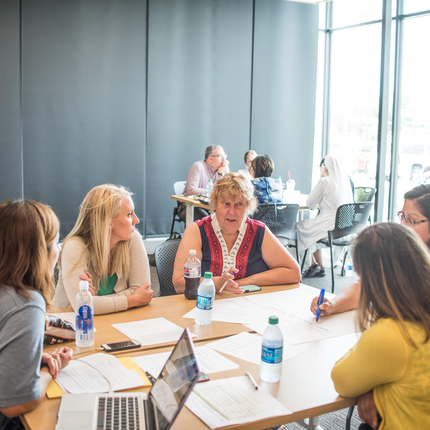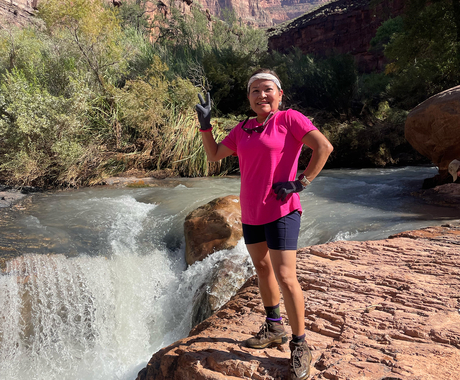The Center for Rural Affairs strives to help create vibrant, rural communities through its work. But, what does that mean to those who live outside of rural America?
Recently, Center for Rural Affairs community organizers Gladys Godinez and Jordan Feyerherm joined host and Civity communications consultant Gina Baleria on the podcast “This is Civity.” Their discussion focused on the work done at the Center to encourage inclusion and connection in rural communities.
Building vibrant, rural communities
The Center for Rural Affairs’ tagline is “unapologetically rural.” The organization stands up for the small family farmer and rancher, new business owner, and rural communities.
“A successful, vibrant, rural community to us is welcoming to all people and inclusive of everyone—the wants, needs, and desires,” said Jordan. “And, also is able to function as a prosperous community staying economically viable, providing homes, and having employment for its residents.”
“One of the things we talk about [at the Center] is social and economic justice, environmental stewardship, and genuine opportunity for all,” said Gladys. “These are things that affect our people and community, and I think we have similar goals to big cities, we just have different ways of approaching them.”
The community organizers expressed a deep connection to the rural roots they hold and how working with the Center helps them recognize those roots, along with helping others do the same.
“If you look at Nebraska’s map, it’s mostly rural land, and we are proud of it—we are part of something bigger than us,” said Gladys. “We’re seeing a lot of individuals who are in their late 20s and early 30s moving back to their rural hometowns because they want to work where they were born. You can’t erase that.”
Gladys stresses the importance of recognizing that while the ideals of rural America hold true all over the country, the appearance of rural America isn’t always the same everywhere.
“We want to be respectful to who we are,” said Gladys. “We’re real, rural, and we look different. We’re not just one shade, we’re not just one color, we’re not just one language. I think it’s very cool that the Center has taken it on in that way, and that we don’t shy away from it. We’re front and center, and we’re trying to help our communities.”
What is Civity, and how is it connected to the Center?
Civity is the idea of purposefully engaging in relationships of respect and empathy with others who are different. This helps community leaders transform those in their towns to understand and celebrate differences—across race, class, culture, and politics. The goal of Civity, as it grows, is to transition a “we/they” mindset to a “we all belong” mindset.
The goals of the Center’s work and Civity program are complementary, and Jordan says bringing the two together happened by being in the right place at the right time.
“Civity had a tool they had already developed,” said Jordan. “It was something that could be adjusted to each community. The goal was to build relationships, to bring people together, and to practice conversation skills that don’t always come to mind, that we don’t always practice with intentionality.”
Using this tool has influenced the work Jordan and Gladys do by allowing them to start conversations between individuals, and eventually bring them together.
“I think inclusion is a new concept for some communities in rural Nebraska and rural America, and for us to be able to say this all starts with one conversation, an intentional conversation, it becomes less scary,” said Gladys. “We are trying to help people find some similarities and also some differences, and figure out who the people in their community are.”
Civity certified
The Center’s connection with Civity goes beyond similar goals and ideas. Jordan is a Civity trainer, which gives him an extra tool when working in communities.
“A big component of my work is offering different trainings and opportunities for people to explore and build on their intercultural competency,” said Jordan. “It’s all about being flexible and giving them what they need at that time. Having Civity is really about learning how to talk with one another in productive ways. It’s giving people permission and structure to deepen the conversation and have those uncomfortable comfortable conversations that sometimes need to be had, or to advance the work that’s on the table.”
Facing challenges, bringing communities together
Roadblocks on the quest for inclusion are not unheard of. Jordan says with the right help, people come together and communities become stronger.
“We’re working toward providing resources and framework for understanding for people who come together who may be quite different from how the town is normally represented,” said Jordan. “It’s a great way to move forward and become stronger overall.”
“In Nebraska, we’re seeing an influx of Latinos, refugees, and migrant workers,” said Gladys. “We need to be welcoming and help our new community members feel like they're part of the community. One of our goals is to build that bridge within the towns that we’re working in.”
Location and language barrier challenges present themselves as well. With most of Nebraska’s rural communities up to 300 miles away from the closest metropolitan area, resources can be hard to come by due to the distance.
“I think it’s important for us to be very welcoming and understanding, that language may be something that we either A) need to learn on both sides, or B) find the ability to communicate with those who we’re trying to welcome into our communities,” Gladys said.
Inclusion isn’t always familiar
Jordan and Gladys have worked with people and communities where inclusion is a new concept and trust must be earned. They take extra steps to make sure their work is all-encompassing, and put in the time it takes to get everyone involved on the same page.
“There are going to be times when people don't want to talk about diversity and inclusion, or times when people are suspicious of your intentions,” said Jordan. “I’ve found it’s beneficial to take it out of the abstract and really bring it into the real world to show how this impacts people.”
“If we’re respectful of the community, and we are genuine about our intentions, then we’re going to be okay,” said Gladys. “I think individuals who don’t agree on some things may find similarities in other things, and that’s what we really try to work at—finding those similarities and understanding our differences, and then moving forward.”
“We show the community members that we’re there for them,” Jordan said. “I think a lot of these communities are hesitant to trust someone who is coming in from outside to work in their community because they want to know why you are there, and if you’re just going to do this one thing and leave. They want stability in their community.”
Jordan emphasizes that taking the time to see where they fit in with the community makes a huge difference in how their ideas are received.
“Complement what the community is already doing with your skills, strengths, and what you have in your inventory to give to the community,” Jordan said. “It has to be relevant and appropriate for what the community is going through at that time. If you add a component to something they’re already doing, that brings a lot more people on your side and it may open doors.”
Importance of relational work
Making connections across different groups of people is a goal in the community organizers’ work, and one they take seriously.
“We want to get to know the individuals and the community before we do any workshops, so that we understand and work with the community to make this a long-term change,” said Gladys. “We’re not here to do a snippet of inclusion, we’re here to assist our communities in understanding inclusion and what that entails, and how they can make that change within their community.”
“You’re not going to become a member of that community completely, but you need to navigate the community in a genuine and respectful way to do anything that has any long-term, lasting effects or impacts on actual change,” said Jordan. “The goal of the work is so very much within changing hearts, minds, and culture thought.”
Spreading the shared language of understanding, and moving forward
Communities must continue to learn and change with the times, as they will grow and change. The willingness to engage with others and keep an open mind are the keys to bringing communities together.
“By introducing allies who may not know each other in the community and by spreading the shared language of understanding, people know who to count on, and they’ll be on the same page with what they need and what they’re trying to do,” said Gladys. “That’s a big component of our work—the networking, the shared language, and the understanding.”
“We want to keep pushing uncomfortable comfortable conversations and creating spaces where people feel that they can have these conversations—where they feel they can ask questions, explore the areas of what it means to be rural, and not be afraid to explore different ways of thinking,” Jordan said.
And, the demographics in rural America are constantly changing.
“We can’t just accept things as they are and let things become static,” Jordan said. “We need to change with the times and keep evolving our concept of what it means to be rural, what it means to be inclusive and welcoming, and how we can best keep our communities vibrant.”





